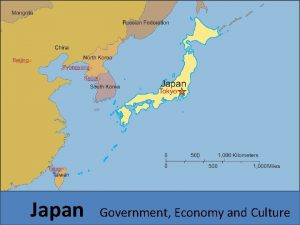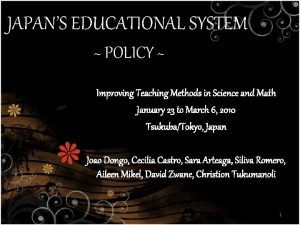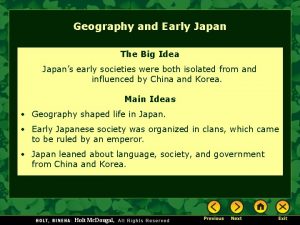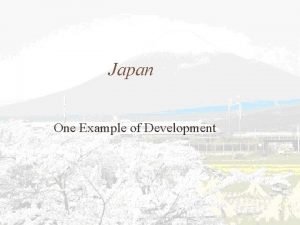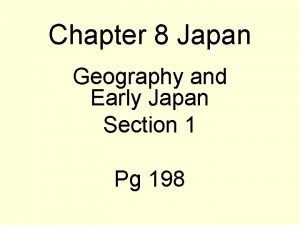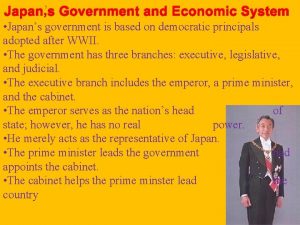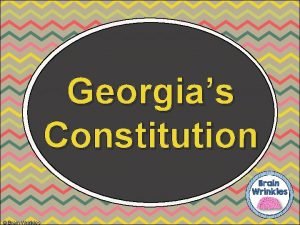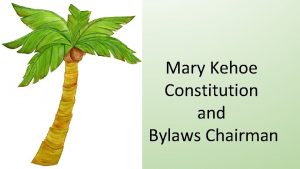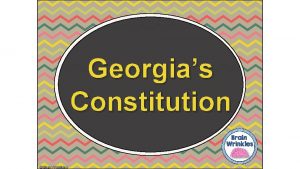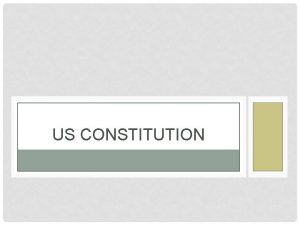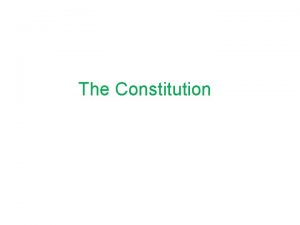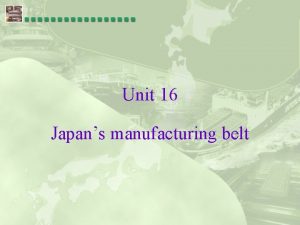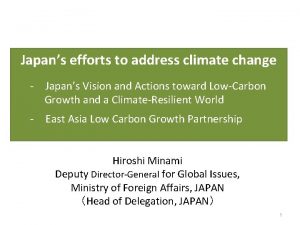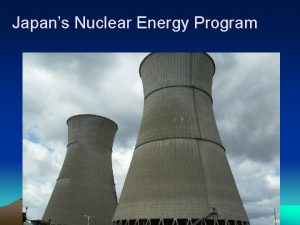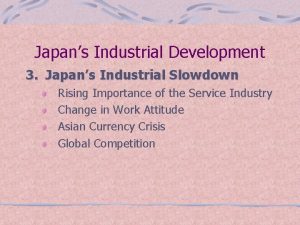Japans Government Mark A Newsom II Japans Constitution












- Slides: 12

Japan's Government Mark A Newsom II

Japan's Constitution Japan's constitution had many changes from the Meiji era and after the surrendering of Japan which officially ended Word War II between America and Japan. During the Meiji era, the constitution was focused around with the emperor as the supreme leader. Prime ministers and cabinet were chosen by the emperor and thus creating the Empire of Japan. After World War II and with Allied Force pressure on top of the unconditional surrender of Japan, the constitution was changed, were as the Emperor no longer held sovereign power and is treated more like a ceremonial figure head. The emperor only appoint someone as prime minister as a formality, whereas the prime minister is selected and appointed within the Diet. The constitution advocate peace and morality, and the base in which the government branches such as the Supreme Court make decisions, while stating that "sovereign power resides with the people", noting in Chapter 1 Article 1 "The Emperor shall be the symbol of the State and of the unity of the People, deriving his position from the will of the people with whom resides sovereign power. "

Left Out • The major issue from the Edo era and throughout the early Meiji era, were the Samurai. • With the creation of a caste system and the rapid modernization that the new government was going many Samurai were not happy with reforms that nearly made the Samurai caste useless. • This would eventually lead up to the Satsuma Rebellion lead by Saigo Takamori. • The rebellion only lasted nine months, from January 29, 1877 to September of that same year with the Samurai's defeat.

Three Branches • Japan has three branches of government, with each having its own role • Legislative: is part of the Diet and is the divided into the House of Representatives and the House of Councilors • Judicial: The Courts, this includes the Supreme Court, high courts and penal system • Executive: The Diet, is the sole law making and the largest of the branches in which a Prime Minister and Cabinet is elected from.

Executive Branch • The Prime Minister and Cabinet make up the executive branch and are selected from the legislative branch which makes up the National Diet. • The Prime Minister has the authority to sign bills, laws, enact national emergency, choose and dismiss its cabinet • The Cabinet role is to create a national buget, oversee treaties and foreign affairs as well as conduct state affairs.

Legislative • The legislative branch or the Diet is composed of two houses: the lower house or the house of representatives and the house of councilors. • In total there are 475 seats in the Diet. It is the sole law-making branch within the Japanese government. As previously mentioned, the Diet elects a prime minister from within and can cast a noconfidence vote directed at the prime minister and or cabinet. • Japanese can vote at the age of 18 for members of Diet. However during this time the house of representatives are dissolved

Judicial • The Supreme Court is the highest court with 14 justices and a chief justices. All who are elected by the cabinet members under the prime minister. • As stated in the constitution, the Supreme Court "is the last resort" when the question of constitutional or unconstitutional is brought up • Other courts under the judicial system are family court, district court, summary court and high court.

How it works

Current Prime Minister • Name: Abe Shinzo • Party: Liberal Democratic Party • Assumed Office: December 26, 2012 (longest running prime minister) • Abenomics: 1) Monetary reform, which goal was to reduce interest rate while increasing inflation. This saw early success, but long term has been difficult. 2)Structural reform, which goal was to help boost economy by removing loopholes in the TPP (Trans-Pacific Partnership). This was unsuccessful due to the with draw of U. S. support under the Trump administration.

The Emperor • https: //www. youtube. com/watch? v=b. Ycys. C 9 H 1 xo

My thoughts • With China, Korea, and Japan at different time, taking similar actions in history ex: the Sengoku era, the closed doors period etc. . . , it was time to change. • Whether for the better or worse, Japan has kept moving forward and will continue to do so. • My approach to this was mixed and I felt like I left out a lot of info trying to sort this out, so for me this was no easy assignment but what little I was able to present will help me understand some of the difference in the current Japanese government and the rest of the world

Work Sited • https: //en. wikipedia. org/wiki/Shinzo_Abe • https: //www. thebalance. com/what-is-abenomics-1979092 • https: //web-japan. org/kidsweb/explore/government/index. html • https: //en. wikipedia. org/wiki/Government_of_Japan • https: //en. wikipedia. org/wiki/Constitution_of_Japan • https: //en. wikipedia. org/wiki/Satsuma_Rebellion • https: //japan. kantei. go. jp/constitution_and_government_of_japan/constitution_e. html
 Japans type of government
Japans type of government Lesson 1 principles of the constitution
Lesson 1 principles of the constitution Texas constitution vs u.s. constitution venn diagram
Texas constitution vs u.s. constitution venn diagram Nc constitution vs us constitution
Nc constitution vs us constitution Constitution what is constitution
Constitution what is constitution Six principles of the constitution
Six principles of the constitution Three branches of government flocabulary
Three branches of government flocabulary Japans educational system
Japans educational system Doko kara kimashita ka in english
Doko kara kimashita ka in english Japans physical geography
Japans physical geography Japans geography
Japans geography Describe japan’s geography.
Describe japan’s geography. Prince shotoku
Prince shotoku
